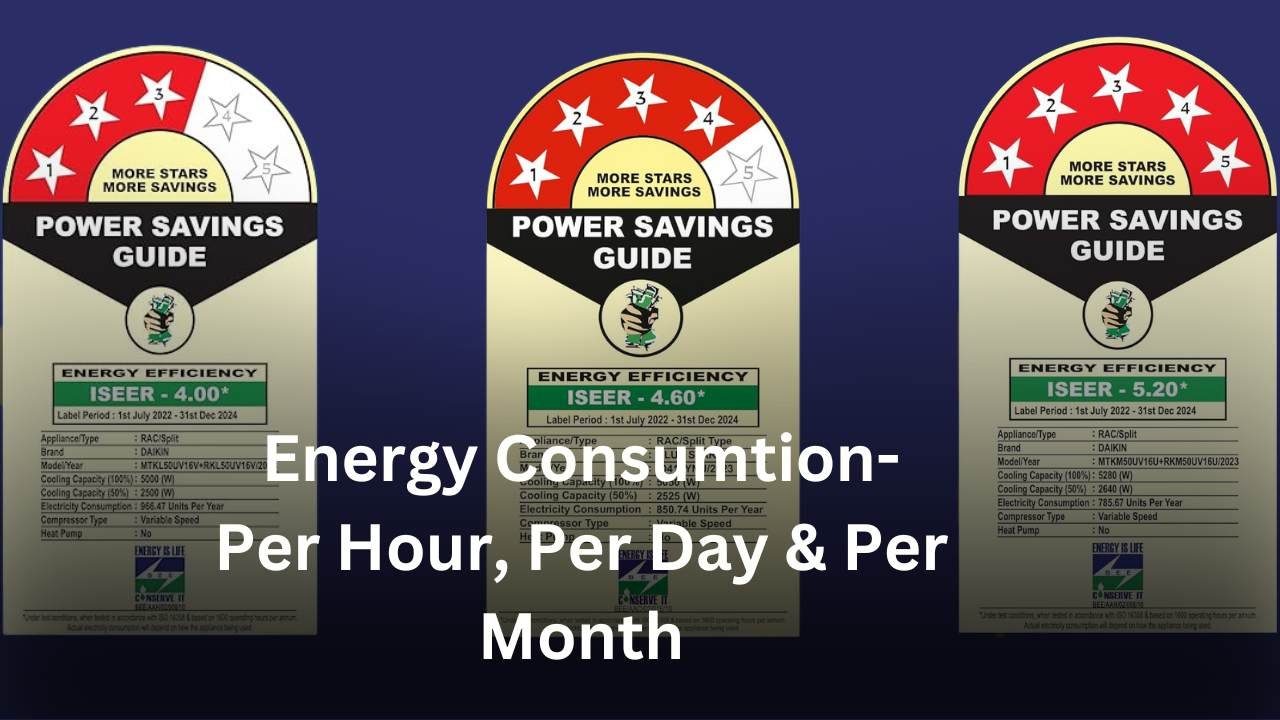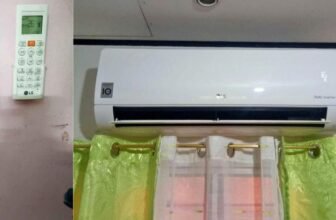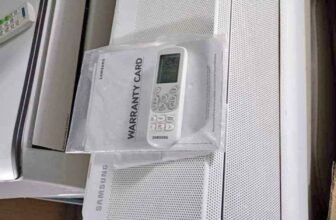
A 5-star 1.5 ton inverter air conditioner consumes 28% less electricity than a 3-star model, according to India’s Bureau of Energy Efficiency. For the average household, this could mean savings of up to Rs. 4,680 per year on electricity bills by opting for a 5-star AC over a 3-star. As rising temperatures drive up demand for residential air conditioning, it becomes very important that consumers make informed choices about energy efficiency when purchasing a new AC unit. In this post, I will show you Power consumption difference of 1.5 ton inverter ac 3 star and 4 star and 5 star.
Distinction Between 3, 4, and 5 Star Ratings
The stars show how good an AC is at saving energy. 3-star ACs are okay but not as efficient as 5-star ones. A higher star means the AC cools better and faster. This lowers energy use and saves you money on bills. This proves that choosing a high-rated AC is better in the long run.
| Star Rating | Energy Efficiency Ratio (EER) | Power Consumption for 1.5 Ton AC (Watts) | Estimated Monthly Cost (₹) |
|---|---|---|---|
| 3 Star | 2.9 – 3.09 | 1104 | 3000 |
| 4 Star | 3.1 – 3.29 | 970 | 2700 |
| 5 Star | 3.3 and above | 840 | 2320 |
Statistical Comparison of Monthly Electricity Consumption
I looked at top brands like Samsung, IFB, Hitachi, LG, Haier, and Panasonic to compare 5-star and 3-star ACs. Let’s see how they fare in terms of electricity use and monthly cost:
| 1.5 Ton AC | ISEER | Maximum Cooling Capacity | Approx Monthly Electricity bill if run 100% capacity ( If 1 Unit = ₹10) If runs 8 Hrs per day |
| LG 1.5 Ton TS-Q19YNZE | 5.2 | 5000 Watts | ₹2307 |
| Daikin 1.5 Ton MTKM50U | 5.2 | 5280 Watts | ₹2436 |
| Hitachi 1.5 Ton 5400FXL RAS.G518PCBIBF | 5 | 4900 Watts | ₹2352 |
| Carrier 1.5 Ton CAI18ES5R34F1 | 5.13 | 5000 Watts | ₹2339 |
| Voltas 1.5 Ton Vectra Elite | 5 | 4900 Watts | ₹2352 |
| Blue Star 1.5 Ton IC518YNURS | 5.02 | 5000 Watts | ₹2390 |
| Godrej 1.5 Ton EI 18IINV5R32 WYS | 5.1 | 4800 Watts | ₹2258 |
| Panasonic 1.5 CS/CU-NU18ZKY5W | 5.1 | 5100 Watts | ₹2400 |
| Lloyd 1.5 Ton GLS18I5FWBEM | 5.2 | 5100 Watts | ₹2353 |
| Samsung 1.5 Ton AR18CYNAMWK | 5.16 | 5000 Watts | ₹2325 |
| Haier 1.5 Ton HSU18K-PYSS5BN-INV | 5.05 | 4850 Watts | ₹2305 |
This comparison shows how choosing the right AC can save you money right away. It also highlights the need to think about power use when buying new appliances. In the end, 5-star models save more on your electricity bill compared to 3-star ones. They prove to be more efficient and cost-effective in the long run.
Energy Efficiency Comparison: Inverter ACs by Star Rating
Inverter ACs allow variable speed compression to match cooling needs, resulting in huge energy savings over fixed speed ACs. The BEE star rating system lets consumers compare energy efficiency, with higher stars indicating more savings. For example, a 1.5 ton 5 star inverter AC can have an EER up to 3.5, while a 3 star is only around 3.1. This can translate to savings of Rs. 80 per month on your electricity bill. Though 5 star ACs cost more initially (Rs. 40,000-67,200 vs Rs. 33,000-85,990 for 3 star), the long-term savings of around Rs. 960 per year make them a worthwhile investment. With sweltering summers ahead, choose wisely and let the stars guide you to energy and cost savings.
Decoding the Power Consumption Analysis for 1.5 Ton Inverter ACs
I look at how much electricity different air conditioners use. This is key for anyone wanting to lower their energy bills. The goal is to use energy smarter.
Electricity Usage Variations Across Different Star Ratings
It’s important to know the effect of star ratings on power use. This knowledge helps us buy wisely. When we compare 3-star and 5-star 1.5 ton ACs, the 3-star uses 1104 watts while the 5-star uses 840 watts.
Charting Power Consumption for 1.5 Ton Units
| Star Rating | Power Consumption (Watts) | Annual Energy Savings (Kilowatt-hours) |
|---|---|---|
| 3-Star | 1104 | 0 |
| 4-Star | 972 | Approx. 280 |
| 5-Star | 840 | Approx. 560 |
This table shows that as star ratings increase, energy use goes down. This means you can save both money and energy. Moving from a 3-star to 5-star unit cuts power use by 264 watts. It also helps the environment by using cleaner energy.
Inverter ACs vs. Traditional ACs: Power Efficiency
When I compare power use, 1.5 ton inverter AC 3 star wins over non-inverter models. Inverter ACs can save a lot of energy over time This stands out when you compare inverter and non-inverter ACs side by side. For example, an inverter AC runs much more efficiently than a standard non-inverter one.
| Type | Power Usage (Watts) | EER |
|---|---|---|
| 3 Star Inverter AC | 1600 | 2.9 – 3.09 |
| Non-Inverter 3 Star AC | More than 1700 | 2.5 – 2.8 |
Power Consumption Difference of 1.5 ton inverter AC 3 star, 4 star and 5 star
As energy bills rise and the demand for AC grows in hot climates like India, understanding air conditioner energy efficiency is key. Looking into star ratings helps with costs upfront and over the long term in energy savings.
Direct Comparison of 3, 4, and 5 Star Inverter ACs
The variance in power use between 1.5 ton inverter ACs with 3, 4, or 5 stars is important. A 5 Star AC uses about 0.26 units per hour, a bit less than the 1.6 units a 3 Star uses. Over months and years, these small differences add up to noticeable savings and better energy use.
Real-World Implications of Choosing Between Star Ratings
Choosing a 3 or 5 Star AC directly affects your power bill each month and is key for budgeting. A 5 Star model might cut your bill to about Rs. 500 from Rs. 580 for a 3 Star. This shows big savings potential and why it’s wise to think about monthly costs and your specific usage before buying.
The energy saving potential doesn’t just save money, it helps the planet by using less energy. So, picking higher-rated ACs may cost more at first, but they pay off with lower bills and help the environment in the long term.
The table below summarises the energy and cost factors for 3 Star and 5 Star 1.5 ton inverter ACs:
| Star Rating | Power Consumption (units/hour) | Typical Monthly Bill (1 Unit = ₹10) | Price Range (₹) |
|---|---|---|---|
| 5 Star | ≈0.92 units/hour | Approx. 2350 | 38,000 to 67,200 |
| 3 Star | ≈1.25 units/hour | Approx. 3000 | 33,000 to 56,990 |
Using this data helps to make a smarter choice when buying an AC, considering both the initial cost and future energy savings. This is more important than ever, as saving every unit benefits both your wallet and the environment.
Calculating Your Air Conditioner’s Energy Usage
Knowing how to watch over your air conditioner’s energy is key. It helps cut down on power costs. Plus, it means you’re doing your bit for the planet. We’ll look at important ways to control your AC’s power use. This helps find the best energy-efficient cooling systems. And it lets you make wise choices when comparing different models.
Factors Affecting AC Power Consumption
Your AC’s use and how much power it takes depend on many things. These include how many people are in the room and the room’s size. Also, the outside and inside temperatures matter. And don’t forget about heat sources like computers or ovens. They add to your AC’s work. Knowing about these factors is your first step to smart power use.
Using the Power Consumption Formula for Cost Estimation

There’s a simple formula to find out how much energy your AC needs.
It is:
Units per month = Maximum Cooling Capacity/ ISEER rating = Result / 1000 = Result X 8 Hrs
= Result X 30 Days
For example, a 1.2 kW AC running 8 hours a day uses about 360 units a month. If one unit costs ₹10, you spend about ₹3600 monthly. But, choosing a more efficient AC can save you a lot of money.
Let’s compare a 3 Star and a 5 Star model. A 5 Star, 1.5-ton AC uses 1.5 units an hour. On the other hand, a 3 Star model uses 1.6 units an hour. Though the difference might not seem big, it adds up over time. Doing a comparison shows the 5 Star AC is better value. It cuts your bill from ₹1000 to ₹1500 a month, with the same usage.
Energy Saving Potential with High Star Rated ACs
I’m drawn to energy-saving tech and have dug deep into high star rated ACs. These systems, especially 1.5-ton inverter models, can save loads of energy. By looking at ACs’ power use, we see why picking higher-rated ones matters. It’s a smart move for cutting energy bills without losing out on cool air.
A 5-star 1.5-ton inverter AC uses only 840 watts, a lot less than a 3-star’s 1104 watts. That’s a huge 28% saving, says the Bureau of Energy Efficiency. This saving isn’t just about money; it boosts how efficient cooling systems are at home.
| Star Rating | Average Power Consumption (Watts) | Estimated Energy Saving Potential |
|---|---|---|
| 3-Star | 1104 | Baseline |
| 4-Star | 972 | Up to 24% |
| 5-Star | 840 | Up to 28% |
Going for a 4 or 5-star AC means you’ll cool better and use less power. A 4-star AC, if it has an EER of 3.0 or more, can save up to 24% more power than a 3-star. This makes them a great pick for folks in hot areas who run their AC lots.
Plus, moving from a 3-star to a 5-star AC pays off in lower bills later. This choice is good for your pocket and the planet. So, the costs at the start, plus the big difference in energy use between 1.5-ton ACs with different stars, really push you to make a wise, money-saving, green choice.
Advantages and Trade-offs of Investing in a Higher Star Rated AC
The world is seeing a rise in air conditioner (AC) use. Soon, the number of ACs could grow by almost two and a half times. In India, cutting down on energy is key because of high electricity prices. Picking the right AC star rating is a big deal for both saving money and the planet. Let’s look at the good and the not so good of going for high star ACs. We’ll talk about how inverter ACs use power and if they’re worth the extra cost.
Evaluating the Higher Upfront Costs
Higher star ACs cost more at the start. This is because they use advanced tech to save energy. Right now, a 5-star inverter AC can be much pricier than a 3-star. But spending more at the beginning can save you money later on your electricity bill. This is all down to the inverter AC’s power efficiency.
Assessing Cooling Performance and Power Savings
The Centre for Energy and Environmental Studies points out that with better star ratings comes chillier air and lower power bills. This is especially important in hot places like India. There, ACs work hard over long periods. Better cooling doesn’t just cut down on power use. It also means fewer greenhouse gas emissions. This helps with green goals.
| AC Rating | Estimated Initial Cost (₹) | Typical Power Usage (Watts) | Potential Annual Savings (INR) |
|---|---|---|---|
| 3-star Inverter AC | 35,000 | 1630 | 0 |
| 4-star Inverter AC | 42,000 | 1420 | 2,200 |
| 5-star Inverter AC | 46,000 | 1250 | 4,680 |
The table clearly shows differences in power use and costs. Even with its high price, a 5-star AC can save you a lot of money every year. It’s a smart buy for those who use their ACs a lot.
After looking at the facts, it’s clear. Choosing a higher star rated AC is good for both your pocket and the planet. They might cost more at first, but they’re cheaper over time. Plus, they help use less energy and reduce air pollution. That’s a win for everyone’s future.
Conclusion
My study into how much power 1.5 ton inverter ACs use at 3, 4, and 5 star ratings offers big lessons for Indian buyers. After looking at how these units compare in energy use, we see picking the best air conditioner is more than wanting cool air. It’s also about saving money and helping the planet. A 5-star AC doesn’t just save up to 28% more energy than a 3-star one. It also cools better thanks to its bigger size.
Studying power use and the tech that adjusts compressor speeds in these ACs hints a 5-star AC is a smart choice, even though it costs more at first. This is especially true for places in India that need air conditioning a lot. Over its life, a 5-star AC can actually save you more money than it costs extra to buy.
To choose between a 3-star and a 5-star AC, think about how much you’ll use it and what you can spend. But, for long-lasting budget-friendliness and caring for the environment, a higher star AC might be the best way to go.






